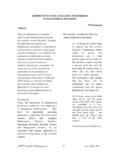Transcription of Six Sigma Methodology
1 QMS GLOBAL LLC Page 1 CLICK ON THE BOOKMARKS -THE SECOND ITEM FROM TOP ON THE LEFT SIDE THEN CLICK THE LINKS TO NAVIGATE Design for Six Sigma (DFSS) DFSS is a systematic Methodology to design new products or processes so that quality is built into every phase of product design. It is also used for improving existing products through redesign. The roots of DFSS are in systems engineering. It combines systems engineering Methodology with statistical methods to achieve built-in quality objectives.
2 DFSS optimizes the critical to quality (CTQ) characteristics to achieve the best system performance. (CTQs are the selected few measurable quality characteristics that are key to a specific product, process, or service that must be controlled to meet or exceed customer expectation). DFSS uses Robust Design, Design of Experiment (DOE), Design for Manufacturability, Simulation and several other tools to optimize product design. DFSS balances the cost and quality. DFSS reduces the development cycle time in the long run.
3 In DFSS, both engineering methods and statistics are used to optimize the design requirements. Like Six Sigma , the DFSS also uses a collection of tools. These tools must be understood in context to the engineering design for achieving DFSS objectives. Design for Six Sigma Methodology The DFSS Methodology has been identified by a five-step process: DMADV that stands for Define, Measure, Analyze, Design, and Verify. These are explained briefly. Define: determine the project need, identify the project goals and objectives, determine customers needs and requirements, and include the voice of customers (VOC) Measure: determine the characteristics critical to quality, prioritize customer needs and requirements, and assess customers needs and CTQ metrics Analyze: evaluate the process options to meet customers need and CTQs Design.
4 Design product and process to meet the customer requirements, include customer requirements in the development process Verify: check the design to ensure that the customers requirements are met The DFSS is also identified by IDOV process that stands for Identify, Design, Optimize, and Validate.. QMS GLOBAL LLC Page 2 IDOV process Identify: Identify customer requirements, and address the voice of customer (VOC) issues. Prioritize customer requirements, use house of quality to identify and define CTQs.
5 Design: Identify product design parameters and characteristics; build a database about the product and related process, and design in key customer requirements. Optimize: Optimize the design to achieve a balance of quality, cost, and time to market. Create robust design that will minimize the impact of variation in the production process. Validate: Demonstrate using data that the product and process is capable, the process capability meets appropriate Sigma level, satisfies the CTQs, and meets the customer s requirements (VOC) and expectations.
6 Design for Six Sigma Tool Tools available to aid in the product design and development process Quality Function Deployment and House of Quality Concurrent Engineering CAD/CAM Robust Design Detailed Design and Analysis (Tolerance Design, Design for Manufacturability, Standardization and Simplification) Failure Mode and Effects Analysis (FMEA) Reliability Testing QFD (Quality Function Deployment): An Important Tool for DFSS Quality Function Deployment (QFD) is an approach used to meet the customers requirements in the product design and development.
7 It helps to integrate the voice of customers and critical quality characteristics in the design of the products so that the products meet or exceed customer expectations. QFD helps eliminate the traditional and wasteful design/redesign efforts by identifying and incorporating customer requirements at the earliest stage of design. Other benefits of QFD include. closer interaction between marketing, design, manufacturing, purchasing, and suppliers reduced product development time, faster market entry, and customer.
8 QMS GLOBAL LLC Page 3 QFD (Quality Function Deployment) Process CustomerRequirementsCustomerImportanceOu rCompanyCompanyACompanyBImprovementGoalI mprovementFactorSalesPointImportanceRati ngVOCC ompetitive EvaluationOur CompanyC o mpany AC ompany BTarget BenchmarkDeploymentTechnical RequirementsInterrelationship MatrixStrong (5)Relationship weighting factors:Moderate (3)Weak (1)Cu s t o me r Ra t i n g5 High, 1 LowRelationships between customerrequirements and technical requirementsPriorities of customer requirements and competitive evaluation1223456 Identify technical requirements to deploy.
9 QMS GLOBAL LLC Page 4 Difference between Six Sigma and Design for Six Sigma Six Sigma Design For Six Sigma (DFSS) Six Sigma aims to improve the existing process by reducing or minimizing the causes of variation. Design for Six Sigma (DFSS) efforts are focused on designing products and processes capable of reaching Six Sigma quality Six Sigma Methodology works within the framework of the existing process. It finds and fixes problems in the existing process. DFSS aims at improving quality at the design phase of products and processes.
10 DFSS is also used to redesign current products and processes. Six Sigma is based on a strategic improvement Methodology known as DMAIC, which stands for Define, Measure, Analyze, Improve, and Control. DFSS is based on DMADV Methodology that utilizes the following phases: Define, Measure, Analyze, Design, and Verify DFSS is also identified by IDOV process that has the following phases Identify, Design, Optimize, and Validate Six Sigma improvement projects are based on the assumption that the design of current product, process, or service is correct and most economical, meets the needs and requirements of customers, and the design satisfies the functional requirements of the customer and market [ Nave,2002].




